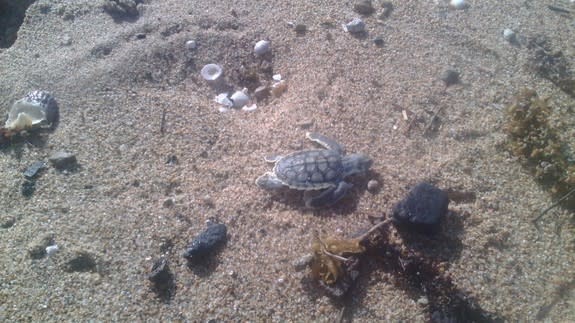Baby turtle found near lumps of coal sparks fears for Great Barrier Reef

Scientists and environmental advocates are up in arms after lumps of coal were found washed up on beaches around Australia's Great Barrier Reef World Heritage Area.
Showing what's at stake for vulnerable marine life, a local found a turtle hatchling next to a lump of coal on East Point Beach in Mackay, Queensland and shared the pictures.
SEE ALSO: Something is very, very wrong with the Arctic climate
Lance Payne spotted the hatchling while wandering the beach early this week. Though he's not part of any environmental group, he felt compelled to share what he saw with authorities. He says the beach is covered in bits of coal and what he believes to be fine black coal dust.
"It's very alarming," he said. "There's coal, potential coal dust and plastic pollution from the streets. "All these awful things happening on the one beach."
While its effect on turtles is not known, scientists regard coal as potentially having a detrimental affect on some marine plants and animals.
Kathryn Berry, a PhD candidate at James Cook University in Queensland, has studied the effects of small coal particles on tropical organisms, including corals, fish and seagrass, in aquarium environments. A 2015 report was published in Nature.
She said that contamination by small coal particles can lower coral survivorship as well as fish and seagrass growth rates.
"There are different ways that coal can cause harm to plants and animals," she explained. "The direct physical effects include smothering and abrasion of plant and animal tissues. When small coal particles are suspended in the water, light levels can be reduced, meaning there is less light reaching plants that require it to photosynthesize."

Image: Lance Payne
Measuring the potential impact of coal contamination is complex, she added, because it depends on the amount of coal spilled and the size of the coal particles. Around the Reef, in particular, there is little data on how much coal is entering the water and where it is going.
"It is simply not good enough for coal to be washing up on beaches in the Great Barrier Reef World Heritage Area," WWF Australia head of oceans Richard Leck said in a statement. "Coal is a potentially toxic material for marine life and must be managed in a way that stops it ending up in Reef waters."
The WFF is calling for a government investigation into the matter, as well as infrastructure changes to prevent coal spillages at nearby mining ports.
Payne's photo comes as the Queensland government found a coal spillage at a mining port in waters near the Reef, ABC reported. The coal appears to have spilled from one of the ship loaders at Hay Point Coal port, as well as spillages from trestles carrying the coal to ship loaders.
The WWF said coal has washed up at East Point Beach and Louisa Creek Beach, not far from the Hay Point Coal port. Environment Minister Steven Miles told the ABC it was not yet possible to say whether Hay Point was the source of the coal.
The federal and Queensland state governments have given the go-ahead to a number of coal ports close by the Reef, including the Abbot Point coal terminal. The terminal will serve the Adani's Carmichael coal mine, which will be one of the world's largest if completed.

Image: Lance Payne
A coal spillage near a World Heritage-listed marine park is always unwelcome, but parts of the Reef are also recovering from a global coral bleaching event.
When stressed by environmental factors such as rising water temperatures and pollution, coral can expel the algae that lives in its tissues, providing it colour and nutrients. Exposing its white skeleton, bleaching leaves coral more vulnerable to disease.
In November, it was announced that the Reef had suffered its largest die-off on record. Its northern section was estimated to lose 67 percent of its shallow water corals. Coral can recover from bleaching, provided it's not exposed to further stresses.
The bleaching event was caused by global warming and an El Niño event, but additional pollutants near the Great Barrier Reef are unwelcome under any circumstances.
"Beginning your first moments as a hatchling beside a lump of coal is not the best start to life," Leck said.
UPDATE: Feb. 9, 2017, 5:12 p.m. AEDT Comment added from Kathryn Berry.
